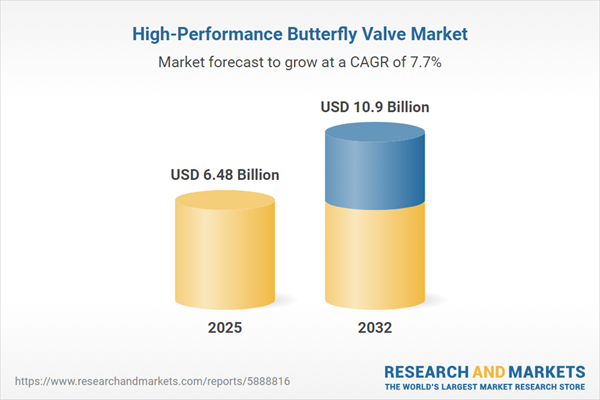Speak directly to the analyst to clarify any post sales queries you may have.
Senior industrial executives require advanced solutions that ensure efficiency, compliance, and adaptability across rapidly evolving operations. The high-performance butterfly valve market offers critical infrastructure for dependable flow control, supporting resilient industrial activity across diverse and dynamic sectors.
Market Snapshot: High-Performance Butterfly Valve Market
The high-performance butterfly valve market is poised for robust growth as organizations increase capital investments in process automation and infrastructure modernization. According to independent research, the market is projected to expand from USD 6.02 billion in 2024 to USD 6.48 billion in 2025, with expectations to reach USD 10.90 billion by 2032. This trajectory reflects a compound annual growth rate of 7.70%, fueled by strong demand in sectors such as chemical processing, oil and gas, and water management. Companies are reevaluating operational strategies to address new compliance demands and are prioritizing scalable, future-ready process solutions to keep pace with changing industry standards and regulations.
Scope & Segmentation: High-Performance Butterfly Valve Market
This market report delivers actionable insight tailored to senior management seeking to optimize procurement, mitigate operational risk, and guide sustainable investment. Detailed segmentation reveals the key value drivers within essential industrial markets:
- Applications: Tailored for chemical processing, oil and gas, power generation, mining, pulp and paper, and water and wastewater management, these valves deliver process safety, operational efficiency, and full compliance across mission-critical operations.
- Valve Types: Options include double flange, triple offset, lug, and wafer configurations, meeting both conventional and highly specialized installation needs across contemporary process industries.
- End Connections: Offered with flanged, lug, and wafer configurations to enable integration across diverse infrastructure, supporting both new and legacy systems for increased flexibility and value over the lifecycle.
- Operation Types: Available with electric, manual, hydraulic, or pneumatic actuation, supporting a range of automation and manual operational requirements throughout industrial and infrastructure environments.
- Pressure Classes: Solutions are classified to meet multiple safety and operational standards, with options tailored for various project and regulatory requirements.
- Seat Materials: A broad selection including metal, stainless steel, Inconel, PTFE, EPDM, and NBR ensures reliability and performance under chemically demanding or abrasive conditions.
- Body Materials: Constructed from carbon steel, alloy steel, stainless steel, and ductile iron, these valves are engineered to deliver strength for corrosive or high-demand operating environments.
- Sizes: Available in a full spectrum from compact to large formats, suitable for a range of applications from space-constrained equipment to large-scale flow management projects.
- Sales Channels: Sourced through direct sales, authorized distributors, and digital procurement channels, these solutions enable responsive, project-specific acquisition and support diverse delivery needs.
- Regions: Spanning the Americas, Asia-Pacific, Europe, Middle East, and Africa, this market features strong industry activity and opportunity in the United States, Canada, China, India, Japan, and Germany.
- Key Companies: Industry leaders such as Flowserve Corporation, Emerson Electric Co., IMI plc, Metso Outotec Corporation, Velan Inc., Pentair plc, Crane Co., KITZ Corporation, Georg Fischer AG, and KSB SE & Co. KGaA are at the forefront of flow control expertise and product innovation.
Key Takeaways for Executive Strategy
- Widespread adoption of digital monitoring and predictive analytics is helping organizations detect operational issues early and improve long-term asset reliability.
- Advancements in seat materials and sealing technology extend service life and reduce the frequency of maintenance, especially under demanding process conditions.
- Triple-offset and zero-leakage designs are improving both safety and operational efficiency for applications involving hazardous or stringently regulated materials.
- Procurement strategies are evolving in response to rapid growth in Asia-Pacific and emerging regions, prompting supply chain diversification and resilience planning.
- Aftermarket features such as remote diagnostics enhance collaboration between suppliers and clients, driving ongoing improvements in automation and maintenance.
Impact of 2025 United States Tariffs on Market Dynamics
New tariffs on steel and alloy imports in the United States have prompted manufacturers to adapt sourcing models, increase domestic procurement, and enhance cost-control measures. Senior leaders are closely monitoring supply chains and adjusting compliance protocols, maintaining strategic flexibility as regulatory environments shift. These actions aim to uphold operational continuity amid fluctuating trade and materials policies.
Methodology & Data Sources
This analysis draws on direct interviews with industry executives, continuous tracking of regulatory trends, and an evaluation of established market whitepapers. Scenario-based modeling supports targeted recommendations, addressing key priorities for decision-makers in this industry.
Why This Report Matters
- Delivers forward-looking insights to help leaders proactively manage regulatory transitions and supply chain exposures, supporting adoption of advanced valve technologies.
- Aids in identifying strategic shifts in procurement and compliance to strengthen sourcing and improve industry competitiveness.
- Highlights opportunities for innovation and growth, guiding operational and investment decisions for long-term resilience.
Conclusion
Targeted, actionable intelligence equips executives to refine operations, drive sustainable growth, and bolster organizational agility within the high-performance butterfly valve market.
Additional Product Information:
- Purchase of this report includes 1 year online access with quarterly updates.
- This report can be updated on request. Please contact our Customer Experience team using the Ask a Question widget on our website.
Table of Contents
3. Executive Summary
4. Market Overview
7. Cumulative Impact of Artificial Intelligence 2025
Companies Mentioned
The companies profiled in this High-Performance Butterfly Valve market report include:- Flowserve Corporation
- Emerson Electric Co.
- IMI PLC
- KSB SE & Co. KGaA
- Metso Outotec Corporation
- Velan Inc.
- Pentair PLC
- Crane Co.
- KITZ Corporation
- Georg Fischer AG
Table Information
| Report Attribute | Details |
|---|---|
| No. of Pages | 195 |
| Published | November 2025 |
| Forecast Period | 2025 - 2032 |
| Estimated Market Value ( USD | $ 6.48 Billion |
| Forecasted Market Value ( USD | $ 10.9 Billion |
| Compound Annual Growth Rate | 7.7% |
| Regions Covered | Global |
| No. of Companies Mentioned | 11 |









